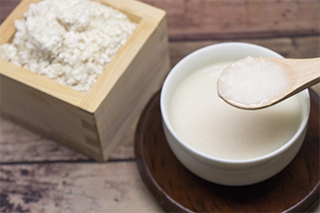Glossary
- English [Romaji]
- Japanese
- Pronunciation
- akaisaké
- あかい酒
Akaisaké is “red saké” and is made by a method patented in Niigata Prefecture, using a variety of kōjikin [mold] named benikōji that gives it a red color. Not to be confused with akazaké. There are other pink products that may receive their coloring from bio-engineered yeast varieties.
- akanuka
- 赤糠
Red powder/dust. The first outer portion of the grain polished away in the rice milling process.
- akazaké
- 赤酒
Akazaké is a rare type of saké particular to Kumamoto Prefecture. Its color is produced from a type of ash added to the fermenting mash.
- amazaké
- 甘酒
Amazaké is sweet and not a true saké at all, but a sweet drink made from saccharified rice.

- arabashiri
- 荒走 り
Arabashiri refers to the first whitish-colored drips that come from the sakabukuro [bag for the mash] that has been hung to separate the liquid from the lees or from the modern press. When the drips are no longer whitish, it is no longer arabashiri [See nakadori/ nakagumi]. The taste profile of arabashiri is young, a bit wild, and brash. The aroma profile is fresh, brilliant, and flowery.
- binzume
- 瓶詰
Bottling.
- ginjōshu
- 吟醸酒
It is one of the special designation sakes (tokuteimeishōshu) made from rice with a polishing ratio (seimaibuai) of 60% or less (40% or more removed) and the addition of a small amount of high-strength distilled alcohol.
- hakumai
- 白米
White rice (Polished/milled rice).
- hiire
- 火入
Pasteurization.
- jōkyō
- 蒸きょう
The process of steaming the rice.
- jōsō
- 上槽
A form of filtration in which fermentation mash (moromi) is pressed, separating it into sake and sakekasu (pressed sake “cake”). The process is also known as assaku (圧搾, literally compression) and should not be confused with the subsequent filtration of the sake itself, which is called roka (濾過).
- kōji
- 麹
Rice cultivated with kōji mold (aspergillus oryzae).
- kōjikin
- 麹菌
The mold (aspergillus oryzae) used in sake production to break down the complex carbohydrates in steamed rice into their component, fermentable sugars.
- kōjimuro
- 麹室
The room in a sake brewery in which the kōji is made.
- komedokoro
- 米所
A rice producing region.
- mizu
- 水
water
- moromi
- 醪
The main fermentation
- moto
- 酛
The fermentation starter
- mushimai
- 蒸米
The rice-steaming step of sake production.
- nama
- 生
unpasteurized
- namachozō
- 生貯蔵
The initial pasteurization of conventional sake is omitted. The sake is stored unpasteurized and undergoes sterilization once, at the product bottling stage only.
- namazake
- 生酒
Unpasteurized sake
- namazume
- 生詰
Sake pasteurized before storage, but omit the second pasteurization at the bottling stage prior to shipping.
- nigami
- 苦味
A term used to describe bitterness.
- nuka
- 糠
Rice dust/powder, a byproduct of rice milling.
- roka
- 濾過
The process of passing a cloudy liquid through paper, cloth or other filtration medium, removing fine solids in suspension to give a clear liquid. Charcoal fining can also be used to remove color from filtered sake.
- sakekasu
- 酒粕
The solid portion left after the mature fermentation mash is pressed to separate sake from the remaining solids. On average, its weight amounts to approximately 20-25% of the original white rice used, though this can exceed 50% in the case of daiginjō.
- sandanshikomi
- 三段仕込み
The three-stage process of adding rice, kōji, and water to the fermentation mash (moromi).
- seihakubuai
- 精白歩合
A term signifying the proportion of the rice milled away.
- seihakuritsu
- 精白率
Refers to the amount/percentage of rice powder/dust removed during milling. The opposite of seimaibuai.
- seikikuhō
- 製麴法
A kōji (steamed rice inoculated with mold) -making method.
- seimai
- 精米
Rice milling/polishing
- seimaibuai
- 精米歩合
The percentage of rice milling/polishing. It refers to the percentage of the rice grain remaining.
- senmai
- 洗米
Washing/rinsing of the rice.
- shinseki
- 浸漬
Soaking ̶ The process of putting the milled rice in water after washing to absorb moisture.
- shinshu
- 新酒
New sake.
- shironuka
- 白糠
The white portion of rice dust/powder collected from milling the outer portion of the rice grain after the red powder (akanuka) has been milled away first.
- shubo
- 酒母
The fermentation starter
- tōji
- 杜氏
A master brewer.
- tokubetsu
- 特別
Tokubetsu is a term used alongside honjōzō and junmai. It means ‘special’ and denotes a special kind of honjōzō or junmai. There are three ways for a sake to qualify for this: 1. The rice is polished to below 60 percent. 2. The sake is made exclusively from sake-specific rice. 3. It includes some other process that the brewer has arranged to be legally recognized.
- tomezoe
- 留添え
The third addition, when building the moromi using the sandanshikomi (three-stage addition) method.
- warimizu
- 割水
Dilution with water.
- yongōbin
- 四合瓶
A bottle containing 720ml. It is the most common sake bottle size in Japan and is based on the gō (equivalent to 180ml), a traditional Japanese measuring unit. Historically, this is how rice was measured, and since sake comes from rice, it made sense to base the bottle size on it. Yongōbin = 4 gō (4 x 180ml) bottle. Hence, the 720ml bottle size.
- yūkigenmai
- 有機玄米
Organic brown rice